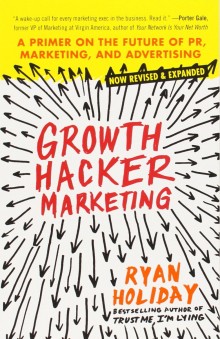
This post has been excerpted from the best-seller Growth Hacker Marketing. Starting immediately, author Ryan Holiday will be hosting an Ask Me Anything live on TNW Academy.
Click the link to ask Ryan anything you want, and he’ll answer your questions in the afternoon EST on Thursday, April 2nd.
“Make something people want.” —Paul Graham
You know what the single worst marketing decision you can make is? Starting with a product nobody wants or nobody needs.
Yet for years, this was a scenario that marketers tolerated and accepted as part of the job. We all told ourselves that “you go to market with the product you have, not the one you want.” And then we wondered why our strategies failed—and why those failures were so expensive.
What attracted me to growth hacking from the very start was that it rejects this obviously flawed approach outright. Growth hackers believe that products—even whole businesses and business models—can and should be changed until they are primed to generate explosive reactions from the first people who see them.
In other words, the best marketing decision you can make is to have a product or business that fulfills a real and compelling need for a real and defined group of people—no matter how much tweaking and refining this takes.
Take Airbnb, a start-up now valued at some $10 billion. Today we know it as a site where, as cofounder Brian Chesky put it, “you can book space anywhere. It can be anything, and it really is anything from a tent to a castle.”
But in 2007, the business started as a way for the founders to turn the living room of their loft apartment into a little bed-and-breakfast. The founders named it airbedandbreakfast.com and put out air mattresses on their floor and offered free homemade breakfast to guests. But the founders wanted more.

Going back to the drawing board and hoping to capitalize on popular technology and design conferences, the founders repositioned the service as a networking alternative for attendees when hotels were booked up.
This was clearly a better market, but the company sensed they could improve the idea further, so they pivoted slightly to target the type of traveler who didn’t want to crash on couches or in hostels but was looking to avoid hotels. This did better still.
Finally, based on feedback and usage patterns, they shortened the name to Airbnb and abandoned the breakfast and networking parts of the business, redefining the service as a place for people to rent or book any kind of lodging imaginable (from rooms to apartments to trains, boats, castles, penthouses, and private islands). This was explosive—to the tune of millions of bookings a year in locations all over the world.
Airbnb had a good idea in 2007, but the actual value proposition, if we’re being honest, was a little mediocre. The founders could have spent all their time and energy trying to force the “let people crash on your floor and feed them breakfast” angle and creating a small business around it.
Instead, they treated their product and service as something malleable and were able to change and improve it until they found its best iteration. They went from a good but fairly impractical idea to an explosive and practical idea, and then as a result, a billion-dollar valuation. This switch was undoubtedly the best marketing decision they ever could have made.
As a traditional marketer, I can think of precisely zero times when we went back to the drawing board after seeing a less-than-stellar response. It wasn’t permitted. Our only move was to put more muscle behind bad products and companies.
It was a wake-up call to me to learn that Airbnb was by no means unique: Instagram started as a location-based social network called Burbn (which had an optional photo feature). It attracted a core group of users and more than $500,000 in funding. And yet the founders realized that its users were flocking to only one part of the app—the photos and filters.
They had a meeting, which one of the founders recounts like this:
“We sat down and said, ‘What are we going to work on next? How are we going to evolve this product into something millions of people will want to use? What is the one thing that makes this product unique and interesting?’”

The service soon retooled to become Instagram as we know it: a mobile app for posting photos with filters. The result? One hundred thousand users within a week of relaunching. Within eighteen months, the founders sold Instagram to Facebook for $1 billion.
I know that seems simple, that the marketing lesson from Instagram is that they made a product that was just awesome. But that’s good news for you—it means there’s no secret sauce, and the second your product gets to be that awesome, you can see similar results.
Just look at Snapchat, which essentially followed the same playbook by innovating in the mobile photo app space, blew up with young people, and skyrocketed to a $3.5-billion-dollar valuation with next-to-no marketing.
Some companies like Airbnb and Instagram spend a long time trying new iterations until they achieve what growth hackers call Product Market Fit (PMF); others find it right away. The end goal is the same, however, and it’s to have the product and its customers in perfect sync with each other.
Eric Ries, author of The Lean Startup, explains that the best way to get to Product Market Fit is by starting with a “minimum viable product” and improving it based on feedback—as opposed to what most of us do, which is to try to launch publicly with what we think is our final, perfected product.
 Look even at the trajectory I went with my experiences on growth hacking. It started with an article I wrote for Fast Company. Then it became a short ebook that sold for $3.99. Then it was expanded and turned into a paperback. And now, it’s been expanded further and most profitably into a course with Fedora.
Look even at the trajectory I went with my experiences on growth hacking. It started with an article I wrote for Fast Company. Then it became a short ebook that sold for $3.99. Then it was expanded and turned into a paperback. And now, it’s been expanded further and most profitably into a course with Fedora.
I didn’t start out thinking it would be any of these things–we iterated and expanded based on customer feedback until we had the perfect product(s).
Today, it is the marketer’s job as much as anyone else’s to make sure Product Market Fit happens. Your marketing efforts are wasted on a mediocre product—so don’t tolerate mediocrity. OK?
But rather than waiting for it to happen magically or assuming that this is some other department’s job, marketers need to contribute to this process. Isolating who your customers are, figuring out their needs, designing a product that will blow their minds—these are marketing decisions, not just development and design choices.
The imperative is clear: stop sitting on your hands and start getting them dirty. Optimizing a product to spread and be well received by customers, by the media, and by influencers is something that you, as a marketer or a growth hacker, are uniquely qualified to do. You are, in effect, the translator who helps bridge the producers and the consumers so they are in alignment.
And this is true whether you’re making some physical gadget, designing a menu, or creating an app. Someone has to be the advocate for the potential market (customers), and the earlier their influence is felt in the process, the better.
Amazon has actually made this part of their basic procedures. Ian McAllister, general manager at Amazon, calls this approach “working backwards from the customer.”
For new initiatives, employees begin by creating an internal press release that announces this new potential project as though it was just finished. It’s addressed to the customers—whoever they happen to be—and explains how this new offering solves their problems in an exciting or compelling way.

If the press release cannot do that, the initiative is tweaked and tweaked and tweaked until it can, according to McAllister, Amazon encourages product managers to think like Oprah—that is, would she rapturously shout about this product if she were giving it away to her fans as a gift?
The exercise forces the team to focus on exactly what its potential new product is and what’s special about it. I guarantee that someone with a mind that bends toward growth hacking put this policy into place.
No longer content to let the development happen as it happens, we can influence it with input, with rules and guidelines, and with feedback. The growth hacker helps with iterations, advises, and analyzes every facet of the business. In other words, Product Market Fit is a feeling backed with data and information.
How do you get PMF?
Because Product Market Fit can be overwhelming as a technical business concept, allow me to explain it by dropping the jargon and presenting an analogy. As it turns out, I was familiar with PMF long before I read Andrew Chen’s article.
Much of the marketing I do is with authors and books. I’ve worked with dozens of bestsellers in the last five years—and, of course, I’ve also worked on many books that weren’t successful.
In my experience, the books that tend to flop upon release are those where the author goes into a cave for a year to write it, then hands it off to the publisher for release. They hope for a hit that rarely comes.
On the other hand, I have clients who blog extensively before publishing. They develop their book ideas based on the themes that they naturally gravitate toward but that also get the greatest response from readers. (One client sold a book proposal using a screenshot of Google queries to his site.) They test the ideas they’re writing about in the book on their blog and when they speak in front of groups. They ask readers what they’d like to see in the book. They judge topic ideas by how many comments a given post generates, by how many Facebook “shares” an article gets. They put potential title and cover ideas up online to test and receive feedback. They look to see what hot topics other influential bloggers are riding and find ways of addressing them in their book.*
The latter achieves PMF; the former never does. One is growth hacking; the other, simply guessing.
One is easy for me to market. The other is often a lost cause. One needs only a small shove to get going. The other has a strong headwind every step of the way.
Amazon, for its part, has a couple of other easy suggestions for you if the advice “write a hypothetical press release” doesn’t quite work for your situation. Their CTO, Werner Vogels, suggests trying to write an FAQ for this product you’re developing. (That way you can address, in advance, potential user issues and questions.)
Or try to define the crucial parts of the user experience by making mockups of pages, writing hypothetical case studies so you can actually start to see what it would look like and who it would work for and how. F
inally, try writing the user manual, which as Werner explains usually has three parts: concepts, how-to, and reference. (Defining these means you understand your idea in and out from the customers perspective. Also, he says, if you have more than one type of user then write multiple manuals.)
I love those ideas. They might feel like homework, but they force you to imagine your product from someone’s perspective other than your own. That’s the best way to get to PMF—because ultimately this isn’t about you; it’s about the people you’re trying to turn into customers.
Perhaps you’ll get to PMF with one aha moment like Instagram, or it may be incremental percent improvements. As Marc Andreessen—the entrepreneur behind Netscape, Opsware, and Ning who, in addition to running a major venture capital fund, happens to be on the board of directors for Facebook, eBay, and HP—explains it, companies need to “do whatever is required to get to product/market fit. Including changing out people, rewriting your product, moving into a different market, telling customers no when you don’t want to, telling customers yes when you don’t want to, raising that fourth round of highly dilutive venture capital—whatever is required.”
In other words: everything is now on the table.
Open up to feedback
Part of this new approach is having the humility to accept that marketers are not necessarily the most critical members of the team. It’s true. Sometimes the best thing marketers can do is to not let people get distracted by “marketing” for a minute. Sometimes the outward-facing part of the job is exactly the least important part.
Take Evernote, a start-up that offers productivity and organization software, which made the company wide decision to delay spending even a penny on marketing for the first several years of its growth.
As Evernote’s founder, Phil Libin, told a group of entrepreneurs in a now-classic talk, “People [who are] thinking about things other than making the best product, never make the best product.”

So Evernote took “marketing” off the table and instead poured that budget into product development. This undoubtedly slowed brand building at first—but it paid off. Why? Because Evernote is far and away the most superior productivity and note-taking application on the planet. Today, it practically markets itself.
Perhaps this is what you need to do. I know you’re probably reading this book looking for some immediate tips you can put into action—places you can deploy your budget or resources. But let’s think outside the box— outside the budget—and consider whether improving your product might be the best strategy.
That’s not to say you shouldn’t do anything at all. Evernote still came up with a bunch of clever tricks to get people to see its products while marketing was on their strategic back burner.
After hearing customers complain that their bosses were suspicious of employees using their laptops in meetings, the Evernote team produced stickers that said, “I’m not being rude. I’m taking notes in Evernote.” Thus, their most loyal customers were turning into billboards that went from meeting to meeting.
Once we stop thinking of the products we market as static—that our job as marketers is to simply work with what we’ve got instead of working on and improving what we’ve got—the whole game changes. Now we are not helpless, repeatedly pitching a product to reporters and users that is not resonating.
Instead, we use this information to improve the product, with the idea of ultimately refining our idea into something that can in many ways sell itself.
The race has changed. The prize and spoils no longer go to the person who makes it to market first. They go to the person who makes it to Product Market Fit first. Because once you get there, your marketing efforts become like a spark applied to a bed of kindling soaked in kerosene. The old way? It’s striking a match…and hoping it starts a fire somewhere.
The point is: marketing as we know it is a waste of time without PMF.
Of course, there are many tools to help get you there. From Google to Optimizely to KISSmetrics, there are great services that allow you to see what your users are actually doing and responding to on your site. This insight will get you closer to a fit than gut instincts ever will.
But the most effective method is simply the Socratic method. We must simply and repeatedly question every assumption. Who is this product for? Why would they use it? Why do I use it?
Ask your customers questions, too: What is it that brought you to this product? What is holding you back from referring other people to it? What’s missing? What’s golden? Don’t ask random people or your friends—be scientific about it. Use tools like Surveymonkey, Wufoo, Qualaroo, or even Google Docs, which make it very easy to offer surveys to some or all of your customers.
For the first time we can ask these questions because we intend to do something about it. No more privately complaining to friends, coworkers, and spouses that we’re stuck with a product nobody wants.
Not to say that you must use all the data that comes back, but you should have it. The black-box approach is no longer necessary. Change is possible—which means you need to make yourself available and open to it.
Product Market Fit is not some mythical status that happens accidentally. Companies work for it; they crawl toward it. They’re ready to throw out weeks or months of
N work because the evidence supports that decision. The services as their customers know them now are fundamentally different from what they were at launch—before they had Product Market Fit.
But once these companies get PMF, they don’t just wait and hope that success will come along on its own. The next step is to bring the customers in.
To learn more about growth hacker marketing, enroll today to get Ryan’s online course and receive a free copy of Ryan’s best-selling book Growth Hacker Marketing: A Primer on The Future of PR, Marketing, and Advertising.
Ryan Holiday is the bestselling author of The Obstacle Is The Way: The Timeless Art of Turning Trials Into Triumphs and two other books. He is editor-at-large at The New York Observer and his monthly reading recommendations are found here. He currently lives in Austin, TX.
Get the TNW newsletter
Get the most important tech news in your inbox each week.




